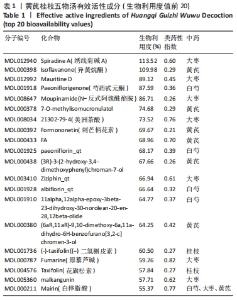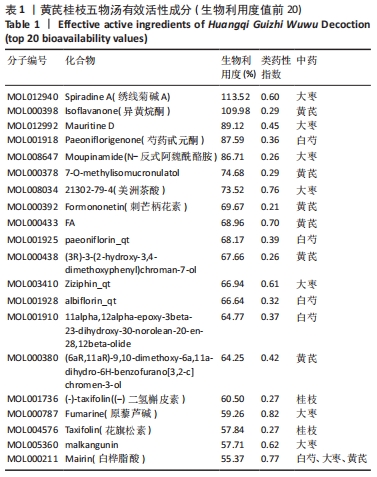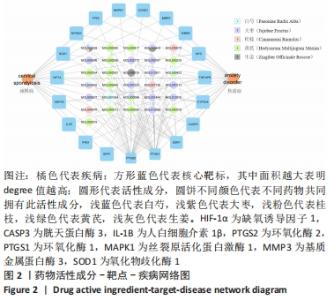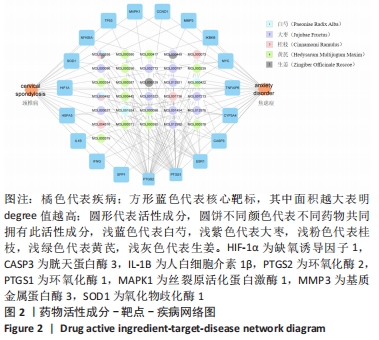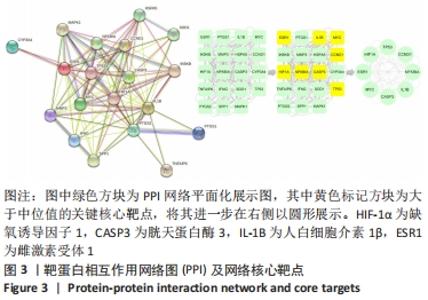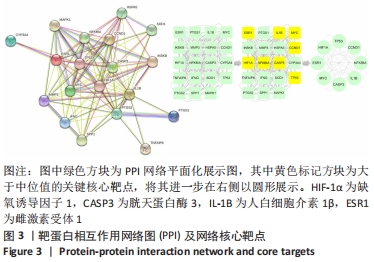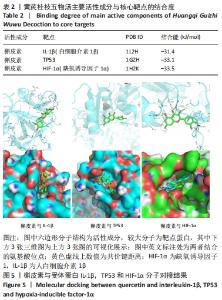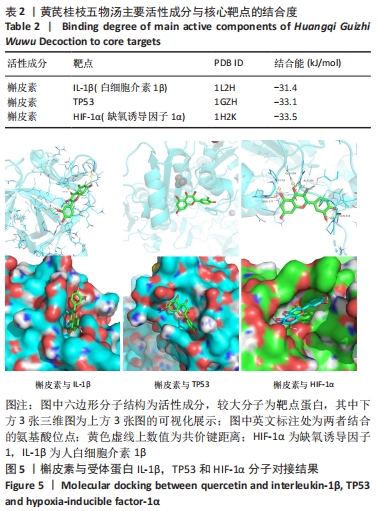Chinese Journal of Tissue Engineering Research ›› 2022, Vol. 26 ›› Issue (23): 3650-3656.doi: 10.12307/2022.663
Previous Articles Next Articles
Mechanisms of Huangqi Guizhi Wuwu Decoction in the treatment of cervical spondylosis and anxiety disorder based on the principle of “treating different diseases with the same method”: a network pharmacology analysis
Deng Bowen1, Li Xiaoye2, Jiang Shengyuan1, Liu Gan1, Zhao Yi1, Zhang Houjun1, He Feng1, Mu Xiaohong1
- 1Dongzhimen Hospital, Beijing University of Chinese Medicine, Beijing 100007, China; 2Psychological Rehabilitation Hospital of Haidian District, Beijing 100086, China
-
Received:2021-09-14Accepted:2021-10-16Online:2022-08-18Published:2022-02-12 -
Contact:Mu Xiaohong, MD, Chief physician, Doctoral supervisor, Dongzhimen Hospital, Beijing University of Chinese Medicine, Beijing 100007, China -
About author:Deng Bowen, MD candidate, Dongzhimen Hospital, Beijing University of Chinese Medicine, Beijing 100007, China
CLC Number:
Cite this article
Deng Bowen, Li Xiaoye, Jiang Shengyuan, Liu Gan, Zhao Yi, Zhang Houjun, He Feng, Mu Xiaohong. Mechanisms of Huangqi Guizhi Wuwu Decoction in the treatment of cervical spondylosis and anxiety disorder based on the principle of “treating different diseases with the same method”: a network pharmacology analysis[J]. Chinese Journal of Tissue Engineering Research, 2022, 26(23): 3650-3656.
share this article
Add to citation manager EndNote|Reference Manager|ProCite|BibTeX|RefWorks
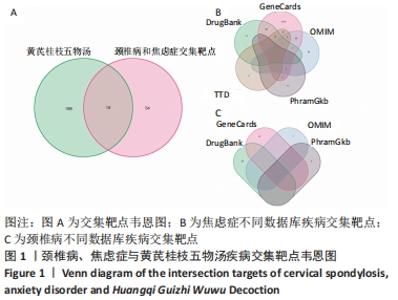
2.2 疾病相关靶点及药物-疾病交集靶点分析 通过Genecards、OMIM、Pharmgkb、TTD以及DrugBank数据库分别获得颈椎病相关基因靶点54,3,5,0,36个;焦虑症基因靶点5 566,200,17,50,146个。通过R软件Venn程序包,将获得靶点合并、去重,共获得颈椎病疾病靶点94个,焦虑症疾病靶点4 903,确定疾病交集靶点73个。将药物活性成分和疾病靶点取交集,利Venn程序包绘制韦恩图,获取共有靶点19个,见图1,3者共有靶点19个,如下:TNFAIP6,PTGS1,PTGS2,CASP3,IKBKB,CYP3A4,ESR1,MYC,MMP3,CCND1,MAPK1,TP53,NFKBIA,SOD1,HIF1A,HSPA5,IL1B,IFNG,SPP1。"
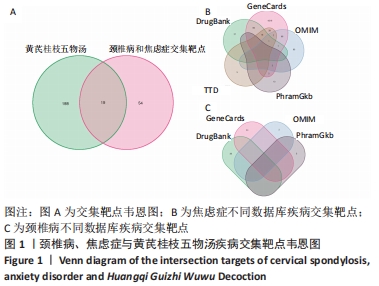
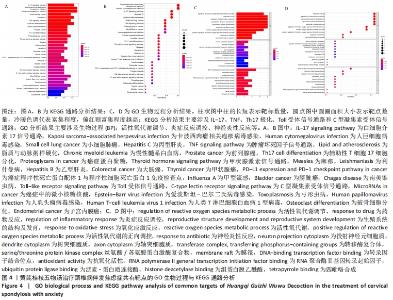
以置信度≥0.400为筛查标准,筛选信息导入Cytoscape 3.8.2软件,利用插件Network Analyzer分析,该网络包含52个节点、128条边,橘色代表疾病,方形蓝色代表核心靶标,圆形代表活性成分,圆饼不同颜色代表不同药物共同拥有此活性成分,网络节点大小和度值呈正相关。网络分析示槲皮素自由度17,紧密度为0.586 2,介度为0.135 9,预测槲皮素是黄芪桂枝五物汤治疗颈椎病和焦虑症共病的主要活性成分,其次为山奈酚(自由度为6,紧密度为0.467 8,介度为0.027 8)、β-胡萝卜素(自由度为4,紧密度为0.443 4,介度为0.008 4)等。同时使用CytoNCA插件和R软件,限定BC、DC、CC、NC、LAC等值均大于中位数,筛选PPI核心网络节点,见图3。上述网络图表示黄芪桂枝五物汤中药材-化合物-靶点-通路相互协同调控,发挥“异病同治”的功效。 2.4 靶点和通路富集分析 使用R软件对19个交集靶点进行GO富集分析和KEGG通路富集分析,根据P大小,列举并分析各类排名靠前条目。GO功能富集分析,获得生物过程(BP)1 212个,主要涉及活性氧代谢过程、炎症反应的调控、氧化应激反应等;细胞组成(CC)17个,主要涉及神经元投射胞浆、树突细胞质、转移酶复合体等;分子功能(MF)81个,主要涉及泛素蛋白连接酶结合、抗氧化活性、RNA聚合酶Ⅱ通用转录起始因子结合等。KEGG通路富集分析获得126条信号通路,其中靠前的通路为白细胞介素17、肿瘤坏死因子、Th17极化、Toll受体信号通路(Toll-like receptor signaling pathway)和C型凝集素受体信号通路(C-type lectin receptor signaling pathway),主要涉及炎症和免疫调控,其后的MAPK,AGE-RAGE,NF-kappa B,PI3K-Akt,HIF-1,Th1 and Th2细胞分化等信号通路,主要涉及细胞凋亡、内分泌代谢、免疫炎症及氧化应激等,表明多通路、多靶点参与了黄芪桂枝五物汤治疗颈椎病和焦虑症共病的过程,见图4。"
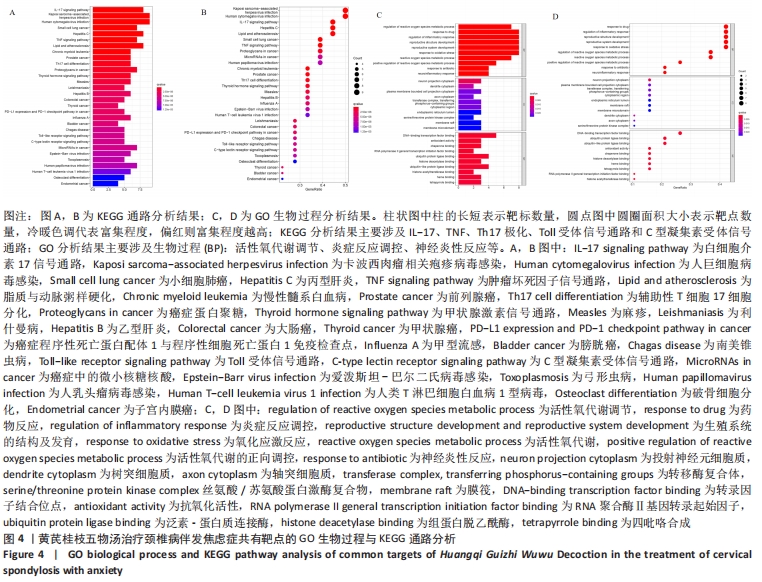
| [1] THEODORE N. Degenerative cervical spondylosis. N Engl J Med. 2020;383(2):159-168. [2] LV Y, TIAN W, CHEN D, et al. The prevalence and associated factors of symptomatic cervical Spondylosis in Chinese adults: a community-based cross-sectional study. BMC Musculoskeletal Disorders. 2018;19:325. [3] GERRITS M, VAN OPPEN P, VAN MARWIJK H, et al. Pain and the onset of depressive and anxiety disorders. Pain. 2014;155(1):53-59. [4] 朱晓旭,谢鸣.焦虑症中医药治疗研究现状(综述)[J].北京中医药大学学报, 2002,25(3):62-65. [5] 陈斌,袁普卫,康武林,等.黄芪桂枝五物汤在骨伤科的应用进展[J].中国中医骨伤科杂志,2015,23(5):71-74. [6] 关静,李峰,宋月晗.“异病同治”的理论探讨[J].中国中医基础医学杂志, 2006,12(9):650-651. [7] 王春晓,谢兴文,李宁.颈椎病病因病机与中医分型[J].中国中医骨伤科杂志, 2010,18(9):64-66. [8] HONG H, KIM BS, IM HI. Pathophysiological Role of Neuroinflammation in Neurodegenerative Diseases and Psychiatric Disorders. Int Neurourol J. 2016; 20(Suppl 1):S2-S7. [9] BAO D, WANG J, PANG X, et al. Protective effect of quercetin against oxidative stress-induced cytotoxicity in rat pheochromocytoma (PC-12) cells. Molecules. 2017. doi: 10.3390/molecules22071122. [10] FAN H, TANG HB, SHAN LQ, et al. Quercetin prevents necroptosis of oligodendrocytes by inhibiting macrophages/microglia polarization to M1 phenotype after spinal cord injury in rats. J Neuroinflammation. 2019;16(1):206. [11] DONG F, WANG S, WANG Y, et al. Quercetin ameliorates learning and memory via the Nrf2-ARE signaling pathway in d-galactose-induced neurotoxicity in mice. Biochem Biophys Res Commun. 2017; 491(3):636-641. [12] LEE YJ, BERNSTOCK JD, NAGARAJA N, et al. Global SUMOylation facilitates the multimodal neuroprotection afforded by quercetin against the deleterious effects of oxygen/glucose deprivation and the restoration of oxygen/glucose. J Neurochem. 2016;138(1):101-116. [13] SAMAD N, SALEEM A, YASMIN F, et al. Quercetin protects against stress-induced anxiety- and depression-like behavior and improves memory in male mice. Physiol Res. 2018;67(5):795-808. [14] LIU P, ZHAO H, LUO Y. Anti-aging implications of astragalus membranaceus (Huangqi): a well-known Chinese tonic. Aging Dis. 2017;8(6):868-886. [15] DEVI KP, MALAR DS, NABAVI SF, et al. Kaempferol and inflammation: from chemistry to medicine. Pharmacol Res. 2015;99:1-10. [16] RAJENDRAN P, RENGARAJAN T, Nandakumar N, et al. Kaempferol,a potential cytostatic and cure for inflammatory disorders. Eur J Med Chem. 2014;86:103-112. [17] AHMAD H, RAUF K, ZADA W, et al. Kaempferol facilitated extinction learning in contextual fear conditioned rats via inhibition of fatty-acid amide hydrolase. Molecules. 2020. doi: 10.3390/molecules25204683. [18] VOET S, SRINIVASAN S, LAMKANFI M, et al. Inflammasomes in neuroinflammatory and neurodegenerative diseases. EMBO Mol Med. 2019. doi: 10.15252/emmm.201810248. [19] CHUNG Y, CHANG SH, MARTINEZ GJ, et al. Critical regulation of early Th17 cell differentiation by interleukin-1 signaling. Immunity. 2009;30(4):576-587. [20] 胡炜,马信龙,袁建军,等.临床症状不同颈椎病患者颈椎间盘白细胞介素1β及白细胞介素6和环氧化酶2的表达[J].中国组织工程研究,2016,20(35): 5270-5276. [21] BEATTIE MS, MANLEY GT. Tight squeeze, slow burn: inflammation and the aetiology of cervical myelopathy. Brain. 2011;134(Pt 5):1259-1261. [22] BEUREL E, LOWELL JA, JOPE RS. Distinct characteristics of hippocampal pathogenic T(H)17 cells in a mouse model of depression. Brain Behav Immun. 2018;73:180-191. [23] JIANG L, HICKMAN JH, WANG SJ, et al. Dynamic roles of p53-mediated metabolic activities in ROS-induced stress responses. Cell Cycle. 2015; 14(18):2881-2885. [24] LEVINE AJ. p53: 800 million years of evolution and 40 years of discovery. Nat Rev Cancer. 2020;20(8):471-480. [25] KASTENHUBER ER, LOWE SW. Putting p53 in Context. Cell. 2017;170(6):1062-1078. [26] RAMMAL H, BOUAYED J, YOUNOS C, et al. Evidence that oxidative stress is linked to anxiety-related behaviour in mice. Brain Behav Immun. 2008;22(8):1156-1159. [27] LI J, TIAN M, HUA T, et al. Combination of autophagy and NFE2L2/NRF2 activation as a treatment approach for neuropathic pain. Autophagy. 2021. doi: 10.15252/emmm.201810248. [28] ZHAO M, ZHANG X, TAO X, et al. Sirt2 in the spinal cord regulates chronic neuropathic pain through Nrf2-mediated oxidative stress pathway in rats. Front Pharmacol. 2021;12:646477. [29] MERELLI A, RODRÍGUEZ J, FOLCH J, et al. Understanding the Role of Hypoxia Inducible Factor During Neurodegeneration for New Therapeutics Opportunities. Curr Neuropharmacol. 2018;16(10):1484-1498. [30] BLUME C, GEIGER MF, MÜLLER M, et al. Decreased angiogenesis as a possible pathomechanism in cervical degenerative myelopathy. Sci Rep. 2021;11(1):2497. [31] Li G, Zhao M, Cheng X, et al. FG-4592 improves depressive-like behaviors through HIF-1-mediated neurogenesis and synapse plasticity in rats. Neurotherapeutics. 2020;17(2):664-675. [32] MCGEACHY MJ, CUA DJ, GAFFEN SL. The IL-17 Family of Cytokines in Health and Disease. Immunity. 2019;50(4):892-906. [33] LUCHTING B, RACHINGER-ADAM B, HEYN J, et al. Anti-inflammatory T-cell shift in neuropathic pain. J Neuroinflammation. 2015;12:12. [34] DOSTERT C, GRUSDAT M, LETELLIER E, et al. The TNF family of ligands and receptors: communication modules in the immune system and beyond. Physiol Rev. 2019;99(1):115-160. [35] CAMARA ML,CORRIGAN F, JAEHNE EJ, et al. TNF-α and its receptors modulate complex behaviours and neurotrophins in transgenic mice. Psychoneuroendocrinology. 2013;38(12):3102-3114. [36] YU WR, BAPTISTE DC, LIU T, et al. Molecular mechanisms of spinal cord dysfunction and cell death in the spinal hyperostotic mouse: implications for the pathophysiology of human cervical spondylotic myelopathy. Neurobiol Dis. 2009;33(2):149-163. |
| [1] | Cui Wei, Cui Di, Ouyang Ting, Li Xiang, Wei Huiting, Xue Weiyue, Zhou Gang, Qiu Ye. Inhibiting NOX alleviates alcoholic liver damage and lipid metabolism disorder [J]. Chinese Journal of Tissue Engineering Research, 2022, 26(在线): 1-8. |
| [2] | LIU Danni, SUN Guanghua, ZHOU Guijuan, LIU Hongya, ZHOU Jun, TAN Jinqu, HUANG Xiarong, PENG Ting, FENG Wei-bin, LUO Fu. Effect of electroacupuncture on apoptosis of neurons in cerebral cortex of rats with cerebral ischemia-reperfusion injury at "Shuigou" and "Baihui" points [J]. Chinese Journal of Tissue Engineering Research, 2022, 26(在线): 1-6. |
| [3] | Tang Wenjing, Wu Siyuan, Yang Chen, Tao Xi. Inflammatory responses in post-stroke depression [J]. Chinese Journal of Tissue Engineering Research, 2022, 26(8): 1278-1285. |
| [4] | Wen Dandan, Li Qiang, Shen Caiqi, Ji Zhe, Jin Peisheng. Nocardia rubra cell wall skeleton for extemal use improves the viability of adipogenic mesenchymal stem cells and promotes diabetes wound repair [J]. Chinese Journal of Tissue Engineering Research, 2022, 26(7): 1038-1044. |
| [5] | Zhang Yujie, Yang Jiandong, Cai Jun, Zhu Shoulei, Tian Yuan. Mechanism by which allicin inhibits proliferation and promotes apoptosis of rat vascular endothelial cells [J]. Chinese Journal of Tissue Engineering Research, 2022, 26(7): 1080-1084. |
| [6] | Li Jian, Bao Zhengqi, Zhou Pinghui, Zhu Ruizhi, Li Zhixiang, Wang Jinzi. Effects of posterior single open-door laminoplasty and anterior cervical corpectomy fusion on cervical sagittal balance parameters in the treatment of multilevel cervical spondylotic myelopathy [J]. Chinese Journal of Tissue Engineering Research, 2022, 26(6): 949-953. |
| [7] | Deng Shuang, Pu Rui, Chen Ziyang, Zhang Jianchao, Yuan Lingyan . Effects of exercise preconditioning on myocardial protection and apoptosis in a mouse model of myocardial remodeling due to early stress overload [J]. Chinese Journal of Tissue Engineering Research, 2022, 26(5): 717-723. |
| [8] | Zhao Yuwei, Gao Yuting, Li Zhen, Hao Huiqin . Mechanism of Ermiao San in the treatment of rheumatoid arthritis [J]. Chinese Journal of Tissue Engineering Research, 2022, 26(5): 742-748. |
| [9] | Zhang Qi, Xiong Yang, Yu Xing, Yang Yongdong, Song Jiawei, Qiu Ziye, Ma Yukun, Jiang Guozheng, Feng Ningning, Wang Shuyang. Mobi-C combined with ROI-C fusion cage versus ROI-C fusion cage alone for the treatment of two-level cervical spondylosis: midterm efficacy follow-up [J]. Chinese Journal of Tissue Engineering Research, 2022, 26(3): 397-402. |
| [10] | Xu Manman, Ji Zhe, Ou Lingdong, Li Ang, Shen Caiqi, Jin Peisheng. Biological characteristics of adipose-derived mesenchymal stem cells in diabetic patients and their effect on promoting wound healing [J]. Chinese Journal of Tissue Engineering Research, 2022, 26(25): 3956-3960. |
| [11] | Chen Na, Wang Xiaohan, Zhang Yunke. Effect and mechanism of mesenchymal stem cells on aging-related ischemic stroke [J]. Chinese Journal of Tissue Engineering Research, 2022, 26(24): 3914-3920. |
| [12] | Xie Yan, Li Wuyin, Xing Weipeng, Pei Yuanyuan, Wang Na. Screening of drugs for inhibiting growth plate chondrocyte apoptosis and the effect of resveratrol on delaying epiphyseal closure in rats [J]. Chinese Journal of Tissue Engineering Research, 2022, 26(23): 3644-3649. |
| [13] | Yang Demeng, Wang Changgeng, Hu Xinyuan, Ao Fei. Protective effect of eucommia alcohol extract on articular cartilage of osteoarthritis model rats [J]. Chinese Journal of Tissue Engineering Research, 2022, 26(23): 3756-3761. |
| [14] | Yao Qipeng, Liao Min. Relationship between electroacupuncture-induced neuroprotection and neuregulin-1/epidermal growth factor receptor 4 signaling pathway in ischemia-reperfusion model rats [J]. Chinese Journal of Tissue Engineering Research, 2022, 26(23): 3664-3669. |
| [15] | Yang Wei, Yuan Puwei, Du Longlong, Li Xuefeng, Gao Qimeng, Han Qingmin. Bioinformatics analysis of gene expression profile of peripheral blood lymphocytes in patients with osteoarthritis [J]. Chinese Journal of Tissue Engineering Research, 2022, 26(23): 3706-3713. |
| Viewed | ||||||
|
Full text |
|
|||||
|
Abstract |
|
|||||
